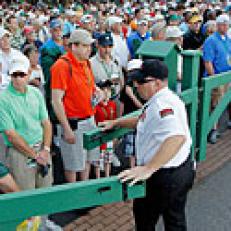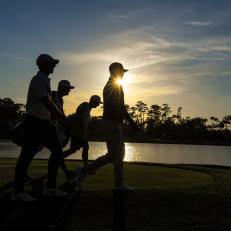The Masters From A to Z
A ...
... is for Amen Corner, that revered three-hole stretch of the rugged par-4 11th, the devilish par-3 12th and the tempting par-5 13th. The name came from the venerable golf scribe Herbert Warren Wind, who first used the tag when describing a decisive sequence there during the 1958 Masters.
B ...
... is for the Butler Cabin, where the Masters winner slips on a green jacket for the first time. It's where every contestant in the field aspires to finish the week, although that means having to endure a frequently awkward ceremony involving Jim Nantz, Augusta National chairman Billy Payne, the low amateur and the previous year's champion.
C ...
... is for Crenshaw, as in two-time Masters champion Ben, who won in his prime in 1984, and then again in unlikely fashion in 1995. The second win came just days after Crenshaw flew home to Texas to attend the funeral of longtime coach Harvey Penick, prompting our Dan Jenkins to write, "This Masters was a very bad week for atheists." C could also be for the Crow's Nest, the spare but cozy living quarters offered to amateurs in the club's cupola.
D ...
... is for Dogwoods, which along with azaleas, are unavoidable on both a physical and symbolic level at Augusta National. They are in glorious bloom around tournament time, meriting repeated mentions on the TV broadcast and in the stories of dozens of smitten sportswriters.
E ...
... is for the Eisenhower Tree. Or at least it was. The Loblolly Pine, situated down the left side of the 17th fairway got its name from former President and Augusta National member Dwight Eisenhower, who wanted the tree cut down because of how often he hit into it off the tee on to have his request denied. Only after an ice storm caused severe damage to the tree earlier this year that it was finally removed.
F ...
... is for Fruitlands Nurseries, which is what the land off of Augusta's Washington Road was until a group headed by Bobby Jones bought it and converted it into Augusta National Golf Club. Many of the plantings at the nursery, including the aforementioned dogwoods and azaleas, are still located on the golf course.
G ...
... is for green jacket, which is what you wear if you're an Augusta National member or a Masters champion (or if, in the case of Arnold Palmer and Jack Nicklaus, you're both). The tradition began for club members as a way to be easily identifiable to guests. Sam Snead became the first Masters champion to be given a green jacket n 1949, and ever since the ensuing champions have been given one.
H ...
... is for the Hogan Bridge, which takes players across Rae's Creek to the 12th green. The bridge, dedicated in 1958, was to honor Ben Hogan's then-record score of 274 in the 1953 Masters. "H" could also be for Honorary Starters, the men who hit the ceremonial first tee shot of the tournament Thursday morning. Jock Hutchison and Fred McLeod were the first to do so in 1963, and the honor is currently held by the trio of Arnold Palmer, Jack Nicklaus and Gary Player.
I ...
... is for IBM, a longtime sponsor of the Masters broadcast, one of the rarest distinctions in sports. As a testament to the tournament's emphasis on ensuring an optimal viewing experience, Augusta National limits its broadcasts to four minutes of ads per hour (Mercedes and AT&T are the other current sponsors). That restraint leaves millions of dollars on the table for the club, but it also allows it to have the autonomy to run the tournament and the broadcast as it wants.
J ...
... is for Jones, as in Bobby, as in the guy most responsible for making Augusta National what it is today. Although it was Jones' partner in founding club, Clifford Roberts, who oversaw the tournament's early growth, it was Jones who gave Augusta immediate credibility, having started the club shortly after winning the Grand Slam in 1930. It was Jones who commissioned Dr. Alister Mackenzie to design Augusta National, and it was Jones who drew the best players and media coverage to the first Augusta National Invitation Tournament in 1934.
K ...
... is for the King, Arnold Palmer, who won four of his seven major championships at the Masters, and remarkably had 12 top 10s in 13 events at Augusta National between 1955-67. During that time, Palmer became golf's premier star, attracting a legion of fans known as "Arnie's Army." Although he didn't seriously contend at the Masters from the mid-1970s on -- and didn't make a cut after the 1983 Masters -- Palmer remains a Masters icon. He stopped playing in 2004, but continues to play in the Par 3 contest and has been an honorary starter since 2007.
L ...
... is for Larry Mize, an Augusta, Ga., native who is author of one of the greatest shots in tournament history. On the second hole of a playoff with Greg Norman in the 1987 Masters, Mize chipped in with a sand wedge from 140 feet. The birdie on No. 11 gave Mize his lone major title and a lifetime return ticket to the Masters. Curiously, though, he has refused to try to duplicate the shot. "It keeps the memory pure," he said.
M ...
... is for Magnolia Lane, the storied entryway to Augusta National Golf Club that features lines of of towering 150-year-old magnolias on both sides. According to Golf Digest's David Owen, the driveway is so narrow that club co-founders Clifford Roberts and Bobby Jones briefly weighed moving the club entrance elsewhere. They eventually reconsidered, and now the drive down Magnolia Lane is one of the guaranteed goose-bump moments for first-time Masters participants.
N ...
... is for Nicklaus, the Masters' most prolific champion who claimed his sixth green jacket in storybook fashion in 1986. It could also be for Nantz, the longtime voice of the tournament on CBS who called his first Masters that same year. Or it could be for Norman, the most snake-bit of Masters contestants, who saw several green jackets slip from his fingers, none more painfully than when he surrendered a six-shot lead on Sunday in 1996.
O ...
... is for Overtime. The Masters is the only major to use a sudden-death playoff format, having switched from an 18-hole playoff in 1976. There have been 10 such playoffs since, including each of the last two years, in wins by Bubba Watson and Adam Scott, respectively. On three occasions -- 1979, 1987, and 2009 -- the playoff has involved three players.
P ...
... is for pimento cheese sandwiched, that curious delicacy that has long been a staple of Masters concession stands. It could also be for Patrons, which is how Augusta National refers to its tournament spectators and, consequently, how they're identified on tournament broadcasts.
Q ...
... is for Quonset Hut, which was the work space for the media from 1953 until a new elaborate facility opened in 1990. The old building was relatively modest structure, a mere fifth the size of its successor, and it featured typewriters instead of laptops with Wi-Fi. But the most important stories from those crucial years of the tournament originated there.
R ...
... is for Rae's Creek, that lovely tributary which winds through Amen Corner and has swallowed a number of balls at pivotal moments over the years. Both the Hogan Bridge (to the 12th green) and the Nelson Bridge (off the 13th tee) cross Rae's Creek.
S ...
__ ... is for Sarazen's Shot Heard 'Round The World,__ the double eagle on the 15th hole in 1935 that led to his win in the second Masters. The accepted wisdom is it was that shot helped elevate the Masters to major championship status. Sarazen, one of five players to win the career Grand Slam, was an honorary starter at the Masters from 1981-99.
T ...
... is for Tea Olive, the name of the intimidating first hole at Augusta National, which features an uphill tee shot and a sprawling bunker waiting along the right side. Noting how most opening holes allow golfers a chance to ease their way in, Nick Seitz wrote in Golf World in 2009 that the first hole at Augusta "is more like a good punch in the mouth."
U ...
... is for the two U.S. Amateur finalists, both of whom earn invitations to the Masters (as well as the U.S. Mid-Am, the U.S. Public Links, and the British Am champs). It's why most Amateur contestants will say the semifinal round actually is more pressure-filled. Lose then and you get nothing. Win and then lose in the final and you're still headed to Augusta.
V ...
... is for Verne Lundquist, another longtime CBS announcer who is responsible for the two greatest calls in Masters history. The first came was "Yes Sir!" in 1986, when Jack Nicklaus holed his birdie putt on No. 17 to take the Masters lead. The other came 19 years later, when Tiger Woods holed his seemingly-impossible chip from off the green on the par-3 16th, to which Verne exclaimed, "In your LIFE have you seen anything like that?!"
W ...
... is for Woods, as in Tiger, whose ascendance to global superstar was complete when he won his first Masters as a pro by a walloping 12 shots in 1997. Woods has since won three more times at Augusta National: to complete his "Tiger Slam" of four straight majors in 2001; when he won the first of two straight majors to start 2002; and his first under swing coach Hank Haney in 2005.
X ...
... is what Billy Casper essentially took as a score in the 2005 Masters. The 1970 Masters champion played the first round in105 strokes, but declined to sign his scorecard, withdrawing after 18 holes in his final Masters appearance. Both the 105 and the 14 the 73-year-old Casper took on the par-3 16th would have been records highs (or is it lows?) for the tournament, but in not making it an official round, it does not register in the record books. Officially, the highest round ever scored at the Masters was a 95 by Charles Kunkle in 1956.
Y ...
... is for yardage, which has been added in healthy numbers at Augusta National in recent years. When Tiger Woods won the 1997 by a walloping 12 strokes, the course played to a mere 6,925 yards. The subsequent "Tiger-proofing" of Augusta National over the years has since stretched it to 7,435 yards. As Ron Whitten wrote in a 2011 feature in Golf Digest detailing every change to Augusta National, no course has been tweaked and tinkered with more than the Masters venue. And as long as there is new technological innovation in golf, you can expect that to be the case.
Z ...
... is for Zoeller, as in Fuzzy Zoeller, the only player to win the Masters in his first attempt, which he did in 1979. True, you might say Horton Smith and Gene Sarazen won in their first Masters when they won in 1934 and 1935, respectively, but that was the first two years of the tournament's existence, when everyone was new. And while Tiger Woods won in his first attempt as a pro, he already had two runs as an amateur under his belt. But when they talk about the challenge for Masters rookies in solving Augusta National, they often cite Zoeller, who outlasted Ed Sneed and Tom Watson in a playoff, as the rare exception.
















